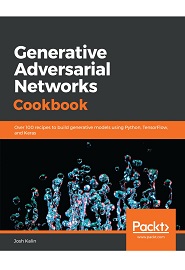
English | 2018 | ISBN: 978-1789139907 | 268 Pages | PDF, EPUB | 34 MB
Simplify next-generation deep learning by implementing powerful generative models using Python, TensorFlow and Keras
Developing Generative Adversarial Networks (GANs) is a complex task, and it is often hard to find code that is easy to understand.
This book leads you through eight different examples of modern GAN implementations, including CycleGAN, simGAN, DCGAN, and 2D image to 3D model generation. Each chapter contains useful recipes to build on a common architecture in Python, TensorFlow and Keras to explore increasingly difficult GAN architectures in an easy-to-read format. The book starts by covering the different types of GAN architecture to help you understand how the model works. This book also contains intuitive recipes to help you work with use cases involving DCGAN, Pix2Pix, and so on. To understand these complex applications, you will take different real-world data sets and put them to use.
By the end of this book, you will be equipped to deal with the challenges and issues that you may face while working with GAN models, thanks to easy-to-follow code solutions that you can implement right away.
What you will learn
- Structure a GAN architecture in pseudocode
- Understand the common architecture for each of the GAN models you will build
- Implement different GAN architectures in TensorFlow and Keras
- Use different datasets to enable neural network functionality in GAN models
- Combine different GAN models and learn how to fine-tune them
- Produce a model that can take 2D images and produce 3D models
- Develop a GAN to do style transfer with Pix2Pix
Resolve the captcha to access the links!